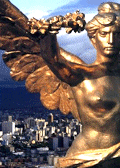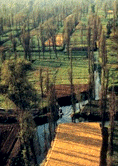| Mexico City | ||||
| Back to Catalog | Home | Attractions | Hotels | Transport |
Like an enormous living
museum, Mexico city is a remarkable showplace for
Mexico´s 3000 years of human cultural achievement. It
ranks as one of the world´s great capitals and is a must
for anyone yearning to understand Mexico´s complex past
and ever challenging future. To many the city
encapsulates the vest and worst of Mexico. The size and
grandeur of the city are staggering. It is not  only the oldest continuously inhabited
city in the Western Hemisphere, but it also carries the
burden of being the largest city the world has ever
known.
only the oldest continuously inhabited
city in the Western Hemisphere, but it also carries the
burden of being the largest city the world has ever
known.
Mexico City is located on an enormous dry lake bed in a highland basin (elevation 7400 feet) surrounded by towering mountains. Its sheer size(population 16.7 million, and an area exceeding 2000 sq. Km.) and improbable location create some formidable urban problems. These include horrific air pollution and traffic (2 million vehicles!), and unchecked urban sprawl. It relentless stimulation of the senses can leave first time visitors bewildered by the city´s chaotic and sometimes exasperating tempo.
But beneath its riveting facade is an endearing and captivating city that has a magnetism not found in other North American cities. With some patience, the city´s engaging history and cosmopolitan character compensate for its glaring urban reality.
Few cities on. earth can match Mexico City for historic grandeur. It is unique in the Western Hemisphere as a colorful and compelling mosaic of Pre-Columbian, European colonial, and modern eras. It is special in the Americas on several counts: foremost is its staging of one of the world´s great human dramas.
It is here that in 1519 the Old World and New World met face to face in a confrontation that would forever shape world history .Mexico City is the exact site upon which the great Mexica /Aztec) civilization flourished, developing one of the greatest cities of the 16th century.
Known as Tenochtitlán, the Aztec capital city was built on a a one-square mile island surrounded by an enormous shallow lake. By the early 1500´s the city was the hub of a powerful commercial and military empire that stretched from Texas to Honduras. It was a city of magnificent places, temples, and markets and was inhabited by some 200000 people.
In what is today the historic center of Mexico City, a band of less than 400 Spaniards under Hernán Cortés confronted and later conquered (with the help of rebellious Aztec enemies) the mighty Aztec empire. Literally atop the rubble of this once-great island city, the Spaniards built their colonial capital. This encounter launched 300 years of European conquest and colonization of Latin America, an vent of monumental consequence to modern Mexican development.
Mexico City is still the economic, political and cultural hub of Mexico .In addition to being the seat of government, nearly all of Mexico’s business and commerce is headquartered here.
It is a vivacious, pulsating city that clamors to be chic and modern while showcasing its colorful ancient roots. It is common to find glass and concrete skyscrapers towering above ancient ruins and palatial colonial-era mansions. Throughout the city are pockets of beautifully preserved remnants of its colonial and Aztec Indian heritage. Astonishing historic sites, ranging from awesome ancient ruins, to meticulously restored, century-old colonial buildings, churches and mansions, to lovely parks and plazas, to grandiose monuments, are found throughout the city. Several serene residential neighborhoods (colonias) have somehow survived in bold defiance of the city’s unwieldy and often unsightly sprawl.
Mexico City’s
historic sightseeing options are limitless, surrounding
visitors with examples of the city’s
larger-than-life past. As the "Manhattan" of
Latin America, its cultural attractions are truly
world-class. Dozens of fine museums cover topics of
varied artistic and academic interest. Music, dance,
theater, and modern art thrive in the city’s
flourishing fine arts community. In fact, the city boasts
130 museums, 64 theaters, 5 stadiums, 7 amusement parks,7
archaeological sites, and 11 ecological parks.
Shopping options range from upscale American-style malls and chic boutiques to colorful native markets. And when it comes to dining, Mexico City showcases gourmet Mexican dishes from every region of the country along side an incredible assortment of international cuisines.
Lodging options are equally varied. As the epicenter of business and government, the city features a limited but well-heeled assortment of international class deluxe hotels. The recent arrival of the Four Seasons and Marriott chains are welcome additions. There are also several smaller four star hotels, plus an enchanting collection of inns, housed in historic colonial era buildings. Business travelers and tourists will appreciate that the city recently was named the most affordable of 125 major cities around the world.
If all this were not enough, Mexico City is also an excellent base from which to explore the surrounding States of Hidalgo, Morelos, Puebla, Mexico, and Tlaxcala. Within 90 minutes of the capital, urban inconveniences melt away as rural Central Mexico unfolds in a mosaic of colonial towns, little visited ancient ruins, alpine forests, and lush semi-tropical valleys.
Note: Upon arrival, pick up a copy of Travelers Guide to Mexico City- a handy reference source assembled by the editors of Travelers Guide to Mexico.